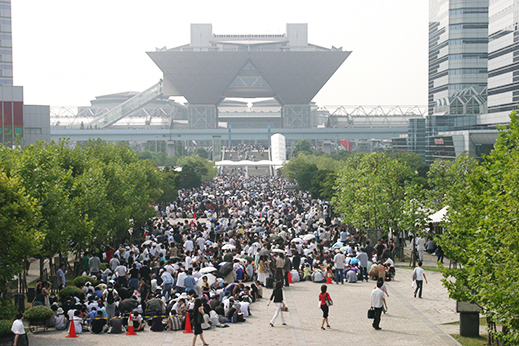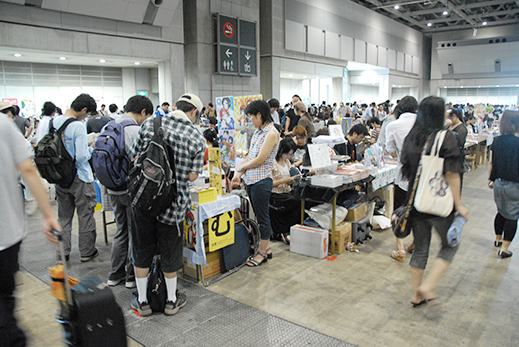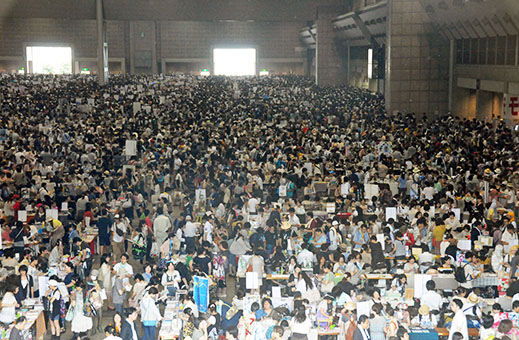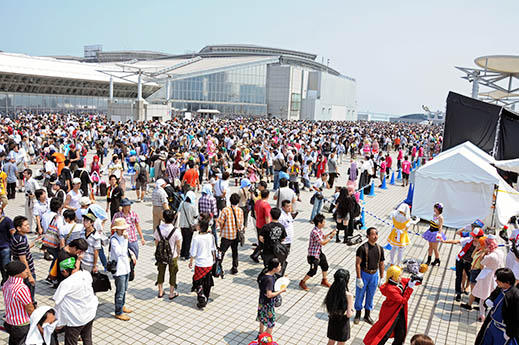 |
Focus features two in-depth reviews each month of fine art, architecture and design exhibitions and events at art museums, galleries and alternative spaces around Japan. The contributors are non-Japanese art critics living in Japan. |
|
|
 |
 |
 |
Manga Unlimited: Tokyo's Comic Market
Lucy Birmingham |
 |
 |
Delve into the world of Japanese pop culture and you're bound to hit upon a gold mine of creativity -- and nowhere more so than at Comic Market, or Comiket for short. With over half a million attending the three-day event every August and December, it's arguably the world's largest gathering of manga fans. The headliners are nonprofessional manga artists displaying their self-published doujinshi works for sale. A maximum of 35,000 "circles" (individual artists and artist groups) are chosen to display their works. A whopping 30 percent of applicants are turned down because of space limitations at the venue -- Tokyo Big Sight, Japan's largest convention center.
The throng this past August included about 20,000 cosplayers, a virtual cornucopia of manga and anime mega-fans dressed in stunning character costumes. Some 130 companies also participated with booths, including Disney, Google and Microsoft. It's an ideal opportunity for them to flex their branding muscle smack in the middle of a massive captive audience of men (40%) and women (60%), averaging in age from the late twenties to early thirties.
Equally remarkable is the fact that Comiket is a not-for-profit entity. The Comic Market Committee (CMC) is the official organizer or "publicist" with a skeletal full-time staff, but it is the approximate 3,100 volunteer-fans that oversee the bulk of operations. Key staff members have found they need to remain anonymous due to the massive number of inquiries, requests and demands with which they are deluged. "Maintaining neutrality is part of it," explains one staff representative. "We don't do advertising. This is a comic market for fans, run by fans. We're all on equal terms. This has been the secret of our success, and an anomaly among commercial ventures."
Interestingly, few artists make any profit at the event. Out of 35,000 publishing circles, 70% lose money. About 15% break even, while the remaining 15% make some profit. "Their purpose isn't to make money but to share their works with others," explains the representative. "Even with the Internet, people want to actually see and meet people. It's an experience. It's not just picking up titles."
 |
A huge diversity in styles and subjects emerges because of the lack of commercial constraints and freedom to create. "This is one of the few hobbies that is demographically egalitarian," says the staff rep. "As long as it's not illegal, we don't care about their gender or what culture they're from."
Trends in subject matter and character popularity shift about every five to ten years, he explains. Now trending are World War II battleships that are anthropomorphized in the shape of cute girls, known as "Fleet Girls" or Kanmusu. Artistic license gone berserk? In fact, the combination has turned out to be a winner. The games have captured an astounding 20 to 30 million viewers by tapping into two Japanese geek markets: military otaku and anime otaku.
"Shoot-'em-up cute girls is big," says the rep. "Along with cute-guy manga. But it comes from gender-bending tendencies in the Japanese manga and anime worlds, a lot more common than it is in the U.S. and Europe." Cute-girl manga are often drawn by men and cute-guy versions by women. "In Japan, social roles are rigid. If you take away the commercial constraints and let people express their imagination, they'll tend to fantasize about being another gender. Like manga and anime, it spills over into other aspects of Japanese society, such as effeminate male pop stars who have lots of female fans."
While hentai (porn) manga is a big draw in any market, Comiket says it sticks to the law. "Comic Market receives one sample of every book placed in offer so our team can check if it is in violation of obscenity restrictions, Penal Code 175, or the Child Pornography Law," explains the staffer. "We set down guidelines such as no child pornography or children being abused. We take very seriously that the intent of the law is to protect children. We also make sure that publishers respect Tokyo's local ordinances about sharing sexually explicit material with minors."
 |
While the number of Japanese attendees has steadily increased, the number of visitors from other countries has spiked in recent years. "We've never had problems with foreign visitors," says the staffer. "Most of them are fans that get a lot of information before they come. We also have an International Desk with multilingual volunteers who try their best to accommodate individual needs. But because we're all volunteers it's not always easy to do that. It's not our job to babysit them. We want to treat all attendees equally." Priority is given to those with special needs, but the staff warns that during the August event, temperatures can reach over 40 degrees Celsius, making it difficult to ensure comfort.
There is no entry fee, but the organizers ask all visitors to purchase the Comic Market catalogue before attending. It lists all the participants and other vital information, and is typically available at the start of December or August in printed form, as a DVD-ROM, or on the Comic Market Website. The catalogue is in Japanese with a condensed section in English, Korean and Chinese. "We don't want to constrain people, but with the huge crowds it's important they know the information beforehand. If you don't know how to get around Comic Market, it's disorienting." The crowds are thickest at the entrance until about 12 noon, with a long line stretching around the venue. Visitors are recommended to come after this peak period.
The staff representative points out the need for safety. "It's very important to make sure people are safe and everything is orderly," he says, adding they've had no major mishaps since Comiket began in 1975.
Comiket is a real-life, mini-composite of Japan's ubiquitous manga and anime worlds. About 11,000 manga titles (actual books, not serials) are published in Japan each year, while the U.S. publishes roughly 3,000. About 1,000 of those are translations. "The U.S. has a population two-and-a-half times bigger than Japan's, and yet the sequential artwork in Japan is much higher [quality]," says the rep. "The rules are more relaxed [in Japan], which allows people to express themselves more. The diversity is a lot more elaborate. Having a large market helps, but you also need a market that's free."
 |
|
| Some views of Comic Market (Comiket) at Tokyo Big Sight on August 13, 2014. Images courtesy of the Comic Market Committee (CMC). |
 |
 |
Lucy Birmingham
Lucy Birmingham is a long-time, Tokyo-based journalist, scriptwriter, author, and former photojournalist. She currently serves as president of the Foreign Correspondents' Club of Japan. She writes regularly for TIME magazine and her articles have appeared in many publications, including the Wall Street Journal, Newsweek, Bloomberg News, and Architectural Digest. As an arts and culture writer her articles have appeared in publications including Artinfo.com, Artforum.com, and ARTnews. She is also a scriptwriter and narrator for NHK (Japan's public broadcaster) and has published several books including Strong in the Rain: Surviving Japan's Earthquake, Tsunami, and Fukushima Nuclear Disaster.
lucybirmingham.com |
|
 |
|